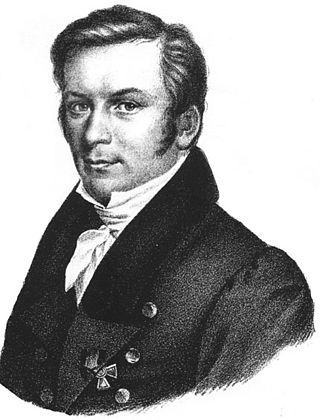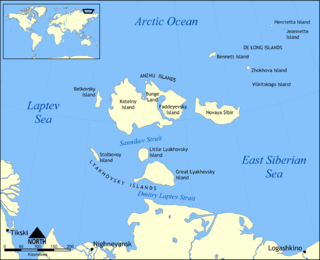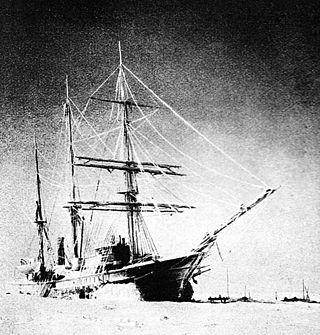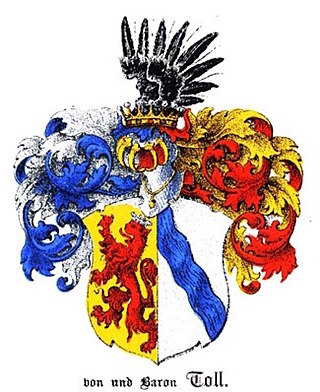
The Lena is a river in the Russian Far East and is the easternmost river of the three, great rivers of Siberia, including the River Ob and the River Yenisey, which flow into the Arctic Ocean. The Lena river is 4,294 km (2,668 mi) long and has a capacious drainage basin of 2,490,000 km2 (960,000 sq mi); thus the Lena is the eleventh-longest river in the world and the longest river entirely within Russia. Geographically, permafrost is the type of soil that underlies most of the Lena river's catchment, twenty per cent (20%) of which is continuous.

The Laptev Sea is a marginal sea of the Arctic Ocean. It is located between the northern coast of Siberia, the Taimyr Peninsula, Severnaya Zemlya and the New Siberian Islands. Its northern boundary passes from the Arctic Cape to a point with co-ordinates of 79°N and 139°E, and ends at the Anisiy Cape. The Kara Sea lies to the west, the East Siberian Sea to the east.

Johann Friedrich Gustav von Eschscholtz was a Baltic German physician, naturalist, and entomologist. He was one of the earliest scientific explorers of the Pacific region, making significant collections of flora and fauna in Alaska, California, and Hawaii.

The New Siberian Islands are an archipelago in the Extreme North of Russia, to the north of the East Siberian coast between the Laptev Sea and the East Siberian Sea north of the Sakha (Yakutia) Republic, of which they are administratively a part.

Baron Ferdinand Friedrich Georg Ludwig von Wrangel was a Russia German explorer and officer in the Imperial Russian Navy, Honorable Member of the Saint Petersburg Academy of Sciences, and a founder of the Russian Geographic Society. He is best known as the chief manager of the Russian-American Company and governor of the Russian settlements in present-day Alaska.

Alexander Georg von Bunge was a Russian botanist. He is best remembered for scientific expeditions into Asia and especially Siberia.

The Yana is a river in Sakha in Russia, located between the Lena to the west and the Indigirka to the east.

Sannikov Land was a phantom island in the Arctic Ocean. Its supposed existence became something of a myth in 19th-century Russia.

Eduard Gustav Freiherr von Toll, better known in Russia as Eduard Vasilyevich Toll and often referred to as Baron von Toll, was a Russian geologist and Arctic explorer. He is most notable for leading the Russian polar expedition of 1900–1902 in search of the legendary Sannikov Land, a phantom island purported to lie off Russia's Arctic coast. During the expedition, Toll and a small party of explorers disappeared from Bennett Island, and their fate remains unknown to this day.

Kotelny Island is part of the Anzhu Islands subgroup of the New Siberian Islands located between the Laptev Sea and the East Siberian Sea in the Russian Arctic. It is administratively and municipally part of Bulunsky District of the Republic of Sakha (Yakutia).

Zarya was a steam- and sail-powered brig used by the Russian Academy of Sciences for a polar exploration during 1900–1903.

Nikolai Nikolaevich Kolomeitsev, also spelt Kolomeytsev, was a naval officer of the Russian Empire and Arctic explorer. During the Russian Civil War, he fought for the Whites.

Fyodor Andreyevich Matisen was an officer of the Russian Imperial Navy, hydrographer, and explorer.

Brusneva Island, is a small island in the Laptev Sea. It is located off the eastern side of the Lena delta in the Tiksi Bay, only 5 km ENE of Tiksi. Its length is 2.3 km and its maximum breadth less than 1 km. The name of this island is also spelt as "Brusnova" in some maps.

Yarok Island is a coastal island in the Laptev Sea, a marginal sea of the Arctic Ocean. The island is located off the mouths of the Chondon, east of the Yana river.

Georg Philipp von Oettingen was a Baltic German physician and ophthalmologist. He was a brother of theologian Alexander von Oettingen (1827–1905), and physicist Arthur von Oettingen (1836–1920).

Eduard August von Regel was a German horticulturalist and botanist. He ended his career serving as the Director of the Russian Imperial Botanical Garden of St. Petersburg. As a result of naturalists and explorers sending back biological collections, Regel was able to describe and name many previously unknown species from frontiers around the world.

The Russian polar expedition of 1900–1902 was commissioned by the Saint Petersburg Academy of Sciences to study the Arctic Ocean north of New Siberian Islands and search for the legendary Sannikov Land. It was led by the Baltic German geologist and Arctic explorer Baron Eduard von Toll on the ship Zarya. Toll and his three assistants vanished in late 1902 while exploring Bennett Island. One of the key members of the expedition was Alexander Kolchak, then a young researcher and lieutenant of the Russian Navy, and later a provisional ruler of Russia during the civil war period. Kolchak also led the rescue mission to find Toll and his crew.

Eduard Hau was a Baltic German painter and graphic artist who lived and worked in the Russian Empire.

The Toll family was a Baltic German noble family of possible Hollandish origin. According to legend, the family's name originated from a castle near Leiden. The family held Swedish and Russian baronial and comital titles, Austrian baronial titles, Prussian, Oldenburgish, Finnish untitled noble status and also possibly belonged to Dutch nobility.




















